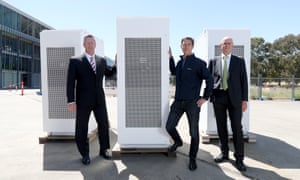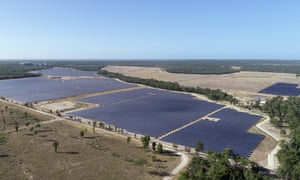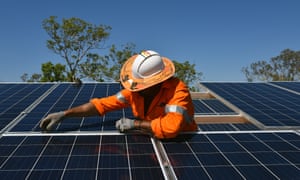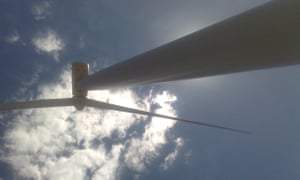There is a growing case that recovery from the coronavirus offers Australia a chance to succeed where it has failed for more than a decade: to break away from the climate wars and head in a new direction.
Here and overseas, the idea of helping jumpstart an economic rebuild after the pandemic-forced shutdown by also tackling the other great existential challenge of the time is gaining currency across the political spectrum.
It has been supported not just by climate activists and conservationists, but by industry, banks, energy companies, unions and major investors.
Kristalina Georgieva, the head of the International Monetary Fund, articulated the push in late April while addressing the heads of 30 countries at the annual Petersberg Climate Dialogue. She rejected the suggestion that the health crisis and the economic crash caused by the “great lockdown” that followed meant steps to fight the climate crisis should be paused.
“Nothing is further from the truth,” she said. “We are about to deploy a massive fiscal stimulus which can help us address both crises at the same time.
“If this recovery is to be sustainable – if our world is to become more resilient – we must do everything in our power to promote a green recovery. In other words, taking measures now to fight the climate crisis is not just a ‘nice-to-have’. It is a ‘must-have’ if we are to leave a better world for our children.”
Implicit in Georgieva’s call is that this may be a one-off opportunity to reduce greenhouse gas emissions and avoid what scientists warn would be a catastrophe for vast swathes of the planet.
Others agree. The German government has called for recovery programs to invest in future-proof jobs that would cut emissions, rather than return to business as usual. Britain has proposed an accelerated take-up of green technologies, saying it could have a profound impact on “our societies’ future sustainability, resilience and, ultimately, wellbeing”.

The idea of a green stimulus has been supported by governments in countries as diverse as Pakistan, Portugal, Canada and the United Arab Emirates, backed by major business energy giants including BP and Shell, and promoted by the World Bank, which has published a series of blog posts with detailed suggestions of how to respond.
Significant money supports this stance. Global investor groups representing members responsible for more than $55tn in assets warned governments to avoid focusing on short-term, big-emitting projects when backing clean growth, which could create jobs while improving things that have a less obvious monetary value – such as clean air. Again, the opportunity borne from crisis was central to the message. “The path we choose in the coming months will have significant ramifications for our global economy and generations to come,” the groups said in a statement.
The Paris-based International Energy Agency, sometimes cited by fossil fuel interests as bullish about their future, called on governments to learn from the global financial crisis, when the rebuild that followed brought the sharpest upswing in carbon dioxide emissions ever recorded. The lesson? “Make smart policy decisions that can put emissions into structural decline this decade,” says the agency’s chief executive, Fatih Birol, warning massive stimulus programs considered now would shape infrastructure for decades to come.
States lead, federal government drags its feet
In Australia, the discussion about a green recovery did not begin as urgently as elsewhere, reflecting perhaps the country’s notoriously difficult climate politics and a media tendency to treat climate as a second-order issue unless it is the subject of a political fight.
That began to change last week. Industry groups the Smart Energy Council and Clean Energy Council hosted online summits on green recovery themes with attendances in the thousands. Speaking at both, Innes Willox, the chief executive of the Australian Industry Group, said recovery from the Covid-19 pandemic and setting a path for net zero were overlapping issues that should be dealt with together to boost growth.
The AIG is among a number of Australian interest groups, research organisations and experts working on what a sustainable rebuild could look like, built on evidence that renewable energy is now the cheapest source to invest in.
Just as striking as Willox’s call was that, across the two summits, every state and the ACT was represented either by a premier, energy minister or, in Tasmania’s case, state-owned clean energy agency. Queensland’s Annastacia Palaszczuk spoke about the potential to develop a battery manufacturing industry and claimed green hydrogen resources would eventually surpass the state’s liquefied natural gas exports. South Australia’s energy minister, Dan van Holst Pellekaan, praised his Labor predecessors for helping develop the state into a world leader in renewable energy generation (while taking a swipe at them over cost) and said he hoped the state would run on 100% clean electricity before 2030.

Fellow Liberal Matt Kean, from New South Wales, said his government was considering its electricity strategy and net zero plan in the wake of the pandemic to see what measures could be brought forward to support the economy. He said they would be subject to three tests: “Will they deliver decarbonisation? Will they deliver jobs? And will they deliver faster economic growth?”
On Thursday, the Tasmanian Liberal government went further, launching a draft renewables energy action plan for reaching 200% renewable energy generation by 2040, a goal that means the creation of a vast clean export industry. The state’s energy minister, Guy Barnett, said the shift to renewable energy was more important than ever in the wake of the pandemic.
“As a result of Covid-19, there are unprecedented challenges facing Australian households and industries. By seizing Tasmania’s immense potential, renewable energy can grow our economy, attract investment, create jobs and support Australia’s transition to renewable supply,” he said.
The states have not walked away from previously held positions – Queensland, for example, quietly announced a support package for the oil and gas industry at the same time that Palaszczuk was making headlines for backing the country’s largest solar farm – but their emphasis was on the opportunities of a clean future, reflecting that each has a goal of reaching net zero emissions by 2050.
The federal government was not represented at either summit, and its emphasis has been in the opposite direction. It supports pumped hydro energy storage projects and green bank the Clean Energy Finance Corporation, but does not have a net zero emissions goal and is promoting a fossil fuel-powered recovery based on gas. The Covid-19 coordination commission, announced by Scott Morrison and headed by the former mining executive Nev Power, appears committed to recommending gas-fired projects and has ignored questions on whether a net zero emissions future consistent with the Paris agreement should be considered.
The government’s fossil fuel focus was noted at the green recovery online sessions and among some watching. Martijn Wilder, a partner at climate advisory and investment firm Pollination and the chairman of the Australian Renewable Energy Agency, says gas plays a stabilising role in the Australian economy at the moment, and is likely to be needed as a feedstock if an energy system is built around hydrogen, but warns: “It is critically important that the Covid-19 commission, in advising the government, ensures any stimulus both grows the economy and does not lock in greenhouse gas emissions or increased climate risk. It really should be following the lead of what’s going on elsewhere in the world.”

Wilder says that includes not just European and some Asian countries but potentially the US, given many states have committed to the principles agreed in Paris. Joe Biden, the Democrats’ presidential nominee in November, has suggested a trillion-dollar infrastructure program that deals “with environmental things that create good-paying jobs”.
“If Biden gets elected there will be a quantum shift in the American approach,” Wilder says. “That is by no means guaranteed to happen, but as an investor you have to prepare for that.”
Practical solutions on the horizon
Groups working on what a green recovery might look like for Australia include Beyond Zero Emissions, which is developing a “million jobs plan” that it says could make the country a renewable energy superpower. The interim chief executive, Eytan Lenko, says there could be more than 300,000 jobs in a national “deep energy retrofit” drive to improve the efficiency of 3m buildings, starting with social housing, low-income homes, schools and hospitals, so they no longer have to pay electricity or gas bills.
Working with an advisory board that includes Malcolm Turnbull and the economist Prof Ross Garnaut, Beyond Zero Emissions is looking at ways to expand clean manufacturing, shift mining and transport to run on clean power and fix Australia’s failing recycling system so that 100% of materials are recovered. “We have a once-in-a-lifetime opportunity to set a direction for Australia’s future development,” Lenko says.
Another not-for-profit, ClimateWorks, recently reported that net zero emissions was within reach for Australia, and released a vision of how it could be achieved as early as 2035 using technologies that are already available. Asked for one step that could put the country on that path, the group’s chief executive, Anna Skarbek, nominates embedding a net zero emissions goal into every part of the economy.

Detailed research by the Grattan Institute suggests an Australian green steel industry could create 25,000 jobs in regional areas that now rely on coalmining, offering a potential path ahead for workers likely to be hardest hit by international steps to cut emissions. Among the report’s conclusions: “Australian governments need to be honest with carbon workers: their attempts to protect carbon jobs from global forces will ultimately fail.”
In one of the most challenging areas to address, the faltering aluminium industry, Simon Holmes a Court, a senior adviser to the Climate and Energy College at the University of Melbourne, is looking at how to give four large smelters, which use up to 15% of electricity from the national grid, a viable future in a renewable energy world. He says technology originally developed in Australia could give them the ability to rapidly dial up or down the amount of energy they consume, turning them into a “virtual battery” that helps stabilise the grid and provides an extra income stream to owners.
Garnaut says the economic crash only strengthens the case that he laid out late last year in his book Superpower – that Australia could have an affordable clean electricity system running at more than three times its existing capacity powering a transformed economy, including new minerals industries.
The former government climate adviser, now a professorial fellow at the University of Melbourne, says entrenched low interest rates should increase the pace at which renewable energy replaces coal, as capital costs are down and the fuel used in clean power generation costs nothing. Among Garnaut’s messages is that governments should not fear taking on greater debt to fuel a low-carbon recovery that could include new or expanded clean industries in hydrogen, aluminium, steel, silicon and ammonia.
Wilder says there is cause to be optimistic. “Ironically, this crisis has pushed climate change to the fore in discussions of the economy around the globe,” he says.
“There is now significant acceptance that climate change is a threat to the economy. And there is an opportunity to rebuild in a way that makes the economy more resilient, if we choose to take it.”
